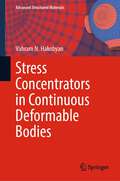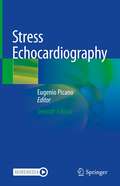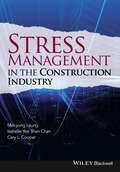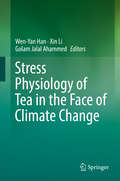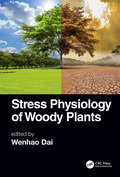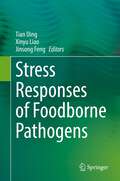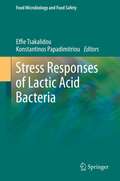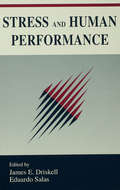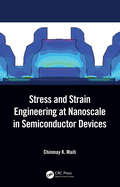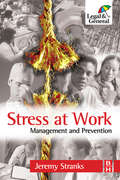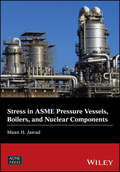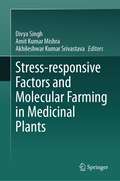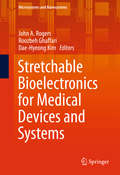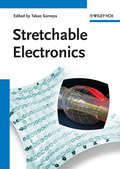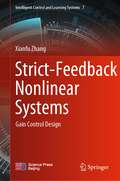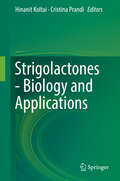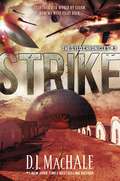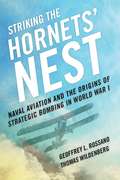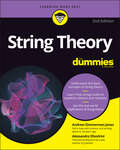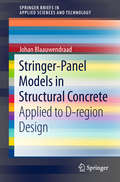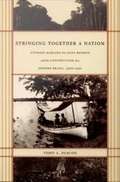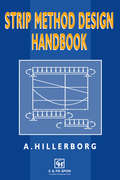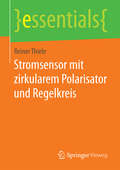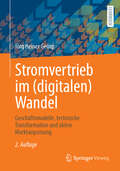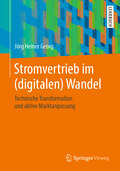- Table View
- List View
Stress Concentrators in Continuous Deformable Bodies (Advanced Structured Materials #181)
by Vahram N. HakobyanThis book is devoted to the study of topical issues of the simultaneous interaction of various types of stress concentrators with massive homogeneous and composite deformable bodies. A wide class of new contact and mixed problems is considered, and their closed or effective solutions are constructed. The features of the dynamic mutual influence of various stress concentrators in some problems of forced vibrations of composite massive bodies are also studied.
Stress Echocardiography
by Eugenio PicanoThis is the seventh edition of a long-selling book (first edition 1991) that was translated into Italian, French, Chinese, Portuguese, Spanish, English. In the last ten years, stress echocardiography has exploded in its breadth and variety of applications. From a one-fits-all approach (wall motion by 2D-echo in the patient with known or suspected coronary artery disease), the field has progressed to an omnivorous, next-generation laboratory employing a variety of technologies (from M-Mode to 2D, from pulsed, continuous, color and tissue Doppler to lung ultrasound) on patients covering the entire spectrum of severity (from elite athletes to patients with end-stage heart failure) and ages (from children with congenital heart disease to the elderly with aortic stenosis). This new edition is enriched with over 300 figures, 150 tables and video-clips. In a societal and economic climate of increasing pressure for appropriate, justified and optimized imaging, stress echocardiography offers the great advantages of being radiation-free, relatively low cost, with minimal environmental impact, and with a staggering versatility: we can get more (information) with less (cost and risk). The volume will be a tremendous aid to current best practices for all health operators who intend to use stress echocardiography and ultrasound for diagnosis and guidance of optimal management in their patients
Stress Management in the Construction Industry
by Cary Cooper Mei-yung Leung Isabelle Yee ChanThis systematic review of stress management in construction will help an understanding of the issues and theory as well as offering practical recommendations. addresses the growing concern to make work in construction healthier, safer, and more productive integrates research results, survey statistics and scenario analyses to reveal underlying causes of stress offers recommendations for reducing Stress
Stress Physiology of Tea in the Face of Climate Change
by Xin Li Golam Jalal Ahammed Wen-Yan HanThis book focuses on the existing knowledge regarding the effect of global climate change on tea plant physiology, biochemistry, and metabolism as well as economic and societal aspects of the tea industry. Specifically, this book synthesizes recent advances in the physiological and molecular mechanisms of the responses of tea plants to various abiotic and biotic stressors including high temperature, low temperature or freezing, drought, low light, UV radiation, elevated CO2, ozone, nutrient deficiency, insect herbivory, and pathogenic agents. This book also discusses challenges and potential management strategies for sustaining tea yield and quality in the face of climate change. Dr. Wen-Yan Han is a Professor and Dr. Xin Li is an Associate Professor at the Tea Research Institute of the Chinese Academy of Agricultural Sciences (TRI, CAAS), Hangzhou, PR China. Dr. Golam Jalal Ahammed is an Associate Professor at the Department of Horticulture, College of Forestry, Henan University of Science and Technology, Luoyang, PR China.
Stress Physiology of Woody Plants
by Wenhao DaiThis book addresses the importance woody plants have in agriculture, forestry, and the environment and how various stresses affect their performance. It reviews physiological and molecular responses of woody plants to major environmental stresses and focuses on the mechanisms involved in imparting resistance to stress. Chapters cover basics of plant physiology including plant structure and plant growth, photosynthesis, respiration, plant growth regulation, abiotic and biotic plant stresses including drought, water logging, nutrient deficiency, salinity, chilling, freezing, heat, oxidative stress, and heavy metal toxicity.
Stress Responses of Foodborne Pathogens
by Tian Ding Xinyu Liao Jinsong FengFood-borne bacterial pathogens encounter a number of stressors during food processing and preservation. More and more pathogens are able to adapt their physiological properties and/or genetic expression to survive these stressors and pose a risk to food safety and public health. This book provides the reader with a comprehensive overview of common food processing-associated stressors (e.g., heat, cold, acid, osmosis, and oxidation) and deals with the molecular basis of the respective bacterial stress response mechanisms (e.g., viable but nonculturable state, biofilm formation, sporulation, and cross-protection response). Additionally, various chapters cover the response mechanisms of foodborne pathogens to emerging nonthermal sterilisation technologies such as ultrasound, high-pressure processing, pulsed electric fields, ultraviolet light, irradiation and phytochemicals. Through this book we also learn about future prospects for the efficient control of stress adaption in foodborne pathogens to ensure maximum consumer safety. This book offers a valuable resource for researchers, graduate students, food process engineers and product developers in the fields of food science and microbiology.
Stress Responses of Lactic Acid Bacteria
by Konstantinos Papadimitriou Effie TsakalidouBeginning with the basics of lactic acid bacteria and stress response, then working into specific fields of research and current developments, Stress Responses of Lactic Acid Bacteria will serve as an essential guidebook to researchers in the field, industry professionals, and advanced students in the area. The exploration of stress responses in lactic acid bacteria began in the early 90s and revealed the differences that exist between LAB and the classical model microorganisms. A considerable amount of work has been performed on the main genera / species of LAB regarding the genes implicated and their actual role and regulation, and the mechanisms of stress resistance have also been elucidated. Recent genome and transcriptome analyses complement the proteome and genetic information available today and shed a new light on the perception of and the responses to stress by lactic acid bacteria.
Stress and Human Performance (Applied Psychology Series)
by Eduardo Salas James E. DriskellThe pace of life in our high technology world has quickened. Industries that do not become more efficient, often by requiring a faster production turnaround with less slack, are superseded. Because of this, workers face an environment in which they must perform under more time pressure and under greater task load, in which stress is more prevalent, and in which consequences of poor performance are more critical than ever before. The dominant, if unstated, psychoanalytic paradigm underlying much stress research over the past fifty years has led to an emphasis on coping and defense mechanisms and to a preoccupation with disordered behavior and illness. Accordingly, almost any book with "stress" in the title will invariably devote a considerable amount of pages to topics such as stress-related disorders, clinical interventions, stress and coping, psychopathology, illness, and health issues. This book presents basic and applied research that addresses the effects of acute stress on performance. There are a large number of applied settings that share the commonalities of high demand, high risk performance conditions, including aviation; military operations; nuclear, chemical, and other industrial settings; emergency medicine; mining; firefighting; and police work, as well as everyday settings in which individuals face stressors such as noise, time pressure, and high task load. This book focuses directly on the effects of acute stress-- defined as intense, novel stress of limited duration--on performance. The effects of stress on task performance, decision making, and team interaction are discussed, as well as the interventions used to overcome them.
Stress and Strain Engineering at Nanoscale in Semiconductor Devices
by Chinmay K. MaitiAnticipating a limit to the continuous miniaturization (More-Moore), intense research efforts are being made to co-integrate various functionalities (More-than-Moore) in a single chip. Currently, strain engineering is the main technique used to enhance the performance of advanced semiconductor devices. Written from an engineering applications standpoint, this book encompasses broad areas of semiconductor devices involving the design, simulation, and analysis of Si, heterostructure silicongermanium (SiGe), and III-N compound semiconductor devices. The book provides the background and physical insight needed to understand the new and future developments in the technology CAD (TCAD) design at the nanoscale. Features Covers stressstrain engineering in semiconductor devices, such as FinFETs and III-V Nitride-based devices Includes comprehensive mobility model for strained substrates in global and local strain techniques and their implementation in device simulations Explains the development of strain/stress relationships and their effects on the band structures of strained substrates Uses design of experiments to find the optimum process conditions Illustrates the use of TCAD for modeling strain-engineered FinFETs for DC and AC performance predictions This book is for graduate students and researchers studying solid-state devices and materials, microelectronics, systems and controls, power electronics, nanomaterials, and electronic materials and devices.
Stress at Work: Management And Prevention
by Jeremy StranksWork-related stress and resulting sickness absence costs the UK economy about £3.7 billion every year (HSE research). In this jargon-free guide, Jeremy Stranks explains what stress is and what causes it, how people respond to stress and cope with it, how stress can be evaluated and managed and what employers’ legal responsibilities are.Written for managers, HR professionals and safety reps, the emphasis of this book is strongly on practical advice and solutions. The author provides simple tools to measure and assess stress and shows how to deal with a range of stress-creating workplace situations, such as bullying, harassment and violence at work. The book also details how to implement a stress management system that complies with the new HSE Management Standards to avoid civil claims and criminal sanctions by the enforcement agencies.End of chapter key points draw out the implications of the preceding text for the employer and an executive summary shows the main aspects that senior management have to be aware of. In addition, the book contains forms and templates to help with managing stress. These are also available for download on the companion website.Stress at Work will also be a valuable reference for students on the following courses as part of modules concerned with Human Factors: NEBOSH Certificate and Diploma courses, MSc courses in Occupational Health and Safety Management, IOSH Managing Safely, British Safety Council diploma and NVQ level 3 and 4 courses in Occupational Safety and Health.Jeremy Stranks has 40 years of experience in occupational safety and health enforcement, management, consultancy and training. He is a founding member of NEBOSH and has lectured on numerous training courses on all aspects of health and safety. His company Safety and Hygiene Consultants offers companies advice in drawing up Health and Safety policies, writing risk assessments and audit procedures.
Stress in ASME Pressure Vessels, Boilers, and Nuclear Components
by Maan H. JawadAn illustrative guide to the analysis needed to achieve a safe design in ASME Pressure Vessels, Boilers, and Nuclear Components Stress in ASME Pressure Vessels, Boilers, and Nuclear Components offers a revised and updatededition of the text, Design of Plate and Shell Structures. This important resource offers engineers and students a text that covers the complexities involved in stress loads and design of plates and shell components in compliance with pressure vessel, boiler, and nuclear standards. The author covers the basic theories and includes a wealth of illustrative examples for the design of components that address the internal and external loads as well as other loads such as wind and dead loads. The text keeps the various derivations relatively simple and the resulting equations are revised to a level so that they can be applied directly to real-world design problems. The many examples clearly show the level of analysis needed to achieve a safe design based on a given required degree of accuracy. Written to be both authoritative and accessible, this important updated book: Offers an increased focus on mechanical engineering and contains more specific and practical code-related guidelines Includes problems and solutions for course and professional training use Examines the basic aspects of relevant theories and gives examples for the design of components Contains various derivations that are kept relatively simple so that they can be applied directly to design problems Written for professional mechanical engineers and students, this text offers a resource to the theories and applications that are needed to achieve an understanding of stress loads and design of plates and shell components in compliance with pressure vessel, boiler, and nuclear standards.
Stress-responsive Factors and Molecular Farming in Medicinal Plants
by Amit Kumar Mishra Divya Singh Akhileshwar Kumar SrivastavaThis contributed volume brings out a comprehensive collection of changes from cellular to molecular levels in medicinal plants under extreme environments. The focus of this book is to address the molecular changes in medicinal plants under different abiotic stresses. Medicinal plants are regarded as rich resources of components that can be used for drug development in the pharmaceutical industry. A few medicinal plants are considered vital sources of nutrients and solicited for their therapeutic properties. Therefore, it is essential to understand medicinal plants' interaction under abiotic stresses as compounds obtained from these plants play an important role in human health. This book is of interest to students, teachers, researchers, scientists, medicinal plant experts, and policymakers. Also, the book provides study material for undergraduate and graduate students of botany, environmental sciences, medicinal and aromatic plants, biochemistry, and biotechnology. National and international scientists working in the area of medicinal plants, drug development, and policymakers will also find this a useful read
Stretchable Bioelectronics for Medical Devices and Systems
by John A. Rogers Roozbeh Ghaffari Dae-Hyeong KimThis book highlights recent advances in soft and stretchable biointegrated electronics. A renowned group of authors address key ideas in the materials, processes, mechanics, and devices of soft and stretchable electronics; the wearable electronics systems; and bioinspired and implantable biomedical electronics. Among the topics discussed are liquid metals, stretchable and flexible energy sources, skin-like devices, in vitro neural recording, and more. Special focus is given to recent advances in extremely soft and stretchable bio-inspired electronics with real-world clinical studies that validate the technology. Foundational theoretical and experimental aspects are also covered in relation to the design and application of these biointegrated electronics systems. This is an ideal book for researchers, engineers, and industry professionals involved in developing healthcare devices, medical tools and related instruments relevant to various clinical practices.
Stretchable Electronics
by Takao SomeyaOn a daily basis, our requirements for technology become more innovative and creative and the field of electronics is helping to lead theway to more advanced appliances. This book gathers and evaluates the materials, designs, models, and technologies that enable the fabrication of fully elastic electronic devices that can tolerate high strain. Written by some of the most outstanding scientists in the field, it lays down the undisputed knowledge on how to make electronics withstand stretching. This monograph provides a review of the specific applications that directly benefit from highly compliant electronics, including transistors, photonic devices, and sensors. In addition to stretchable devices, the topic of ultraflexible electronics is treated, highlighting its upcoming significance for the industrial-scale production of electronic goods for the consumer.Divided into four parts covering:* Theory* Materials and Processes* Circuit Boards* Devices and ApplicationsAn unprecedented overview of this thriving area of research that nobody in the field - or intending to enter it - can afford to miss.
Strict-Feedback Nonlinear Systems: Gain Control Design (Intelligent Control and Learning Systems #7)
by Xianfu ZhangThis book describes the research progress of the control design about strict-feedback nonlinear systems. A novel gain control design method is proposed, which greatly simplifies the construction procedure of controller for strict-feedback nonlinear systems. The control design problem of strict-feedback nonlinear systems is converted into the determination problem of gain parameters or the construction of dynamic gain equations. Therefore, the tedious iterative design procedure is effectively avoided. This book can be used as a reference for researchers in the field of control theory and engineers seeking advanced methods in practical control applications.
Strigolactones - Biology and Applications
by Hinanit Koltai Cristina PrandiThis book describes the exciting biology and chemistry of strigolactones. Outgrowth of shoot branches? Development of lateral roots? Interactions with beneficial microorganisms? Avoiding parasitic plants? Responding to drought conditions? These important “decisions” that plants make are all regulated by a group of hormones called strigolactones.The latest research has yielded a number of new biological concepts, such as a redefinition of plant hormones and their crosstalk, new functional diversity of receptors, hormonal “smoke and mirrors,” core signaling pathways, and even phloem transport of receptor proteins. Another important aspect of strigolactones is the related synthetic chemistry, which could pave the way for a variety of potential applications in agriculture and medicine.The book explains in detail the role that strigolactones play in plant development, and addresses the interaction of plants with soil biota and abiotic stress conditions, prospects of strigolactone biochemistry and evolution, and chemical synthesis of natural strigolactones and analogs, together with their potential applications. Including a glossary and end-of-chapter synopses to aid in comprehension, it offers a valuable asset for teachers, lecturers and (post-) graduate students in biology, agronomy and related areas..
Strike: The SYLO Chronicles #3 (The SYLO Chronicles #3)
by D. J. MacHale#1 New York Times bestselling author D.J. MacHale is back with the third book in the SYLO Chronicles. Once again, Tucker Pierce and friends must fight for their lives against the better-equipped SYLO. All bets are off in Strike--with twists so big readers will never see them coming--while the action and pulse-pounding suspense remain as high as ever. Fans will be sure to devour this incredibly satisfying conclusion.Praise for the SYLO Chronicles: "A relentlessly fast-paced, intriguing, expertly-written tale that leaves you breathless and satisfied, yet wanting more. Highly recommended."--James Dashner, New York Times bestselling author of the Maze Runner series "Absolutely un-put-downable, more exciting than an Xbox and roller coaster combined."--Kirkus, starred review"If you're a fan of The Maze Runner and Alex Rider, you might want to pick up SYLO. . . . A fast-paced read and a huge cliffhanger."--EW.com"With this extremely high-octane story that's the equivalent to a summer movie blockbuster, MacHale kicks off an apocalyptic trilogy sure to leave readers demanding the next installment."--Booklist"This action-filled, end-of-the-world-as-we-know-it adventure . . . should leave teen readers clamoring for the next installment."--VOYA"An entertaining and creepy tale."--Publishers Weekly"MacHale pens some terrific and unique action scenes. . . will leave readers hungry for the next installment."--School Library Journal
Striking The Hornets' Nest: Naval Aviation And The Origins Of Strategic Bombing In World War I
by Thomas Wildenberg Geoffrey L. RossanoStriking the Hornets’ Nest provides the first extensive analysis of the Northern Bombing Group (NBG), the Navy’s most innovative aviation initiative of World War I and one of the world’s first dedicated strategic bombing programs. Very little has been written about the Navy’s aviation activities in World War I and even less on the NBG. Standard studies of strategic bombing tend to focus on developments in the Royal Air Force or the U. S. Army Air Service. This work concentrates on the origins of strategic bombing in World War I, and the influence this phenomenon had on the Navy’s future use of the airplane. The NBG program faced enormous logistical and personnel challenges. Demands for aircraft, facilities, and personnel were daunting, and shipping shortages added to the seemingly endless delays in implementing the program. Despite the impediments, the Navy (and Marine Corps) triumphed over organizational hurdles and established a series of bases and depots in northern France and southern England in the late summer and early fall of 1918. Ironically, by the time the Navy was ready to commence bombing missions, the German retreat had caused abandonment of the submarine bases the NBG had been created to attack. The men involved in this program were pioneers, overcoming major obstacles only to find they were no longer needed. Though the Navy rapidly abandoned its use of strategic bombing after World War I, their brief experimentation directed the future use of aircraft in other branches of the armed forces. It is no coincidence that Robert Lovett, the young Navy reserve officer who developed much of the NBG program in 1918, spent the entire period of World War II as Assistant Secretary of War for Air where he played a crucial role organizing and equipping the strategic bombing campaign unleashed against Germany and Japan. Rossano and Wildenberg have provided a definitive study of the NBG, a subject that has been overlooked for too long.
String Theory For Dummies
by Andrew Zimmerman Jones Alessandro SfondriniUnravel the secrets of the universe and untangle cutting-edge physics Yes, you actually can understand quantum physics! String Theory For Dummies is a beginner’s guide, and we make it fun to find out about the all the recent trends and theories in physics, including the basics of string theory, with friendly explanations. Build a foundation of physics knowledge, understand the various string theories and the math behind them, and hear what the opponents to string theory have to say. It’s an exciting time to be alive in advanced physics, and this updated edition covers what’s new in the string world—the Large Hadron Collider, the Higgs Boson, gravitational waves, and lots of other big headlines. Unleash your inner armchair physicist with String Theory For Dummies. Brush up on the basics of physics and the approachable math needed to understand string theory Meet the scientists who discovered string theory and continue to make waves (and particles) in the physics world Understand what it’s all about with real-world examples and explanations Learn why string theory is called "The Theory of Everything"—and what it means for technology and the future Aspiring scientists or life-long learners will both be able to gain valuable information from this book. This accessible intro into string theory is for the theorists inside anyone.
Stringer-Panel Models in Structural Concrete: Applied to D-region Design (SpringerBriefs in Applied Sciences and Technology)
by Johan BlaauwendraadStructural concrete designers nowadays distinguish between B-regions (named after Bernoulli beam theory) and D-regions (D standing for ‘disturbed’). They are all familiar with B-regions, but less acquainted with the expertise required for D-regions. To design D-regions, the Strut-and-Tie Model (STM) is usually applied, a model laid down worldwide in structural codes of practice. The Stringer-Panel Model (SPM) recommended here is a companion method to the STM, with the advantage of being suitable for different load cases and reversed loading. This being so, the SPM is suitable for linear-elastic analyses where durability is a key consideration, but also suits structural design for contexts of cyclical seismic activity. Finally, this book sets out how structural engineers who prefer the STM can nevertheless apply the SPM to determine a proper strut-and-tie model.
Stringing Together a Nation: Cândido Mariano Da Silva Rondon and the Construction of a Modern Brazil, 1906-1930
by Todd A. DiaconFocusing on one of the most fascinating and debated figures in the history of modern Brazil, Stringing Together a Nation is the first full-length study of the life and career of Cndido Mariano da Silva Rondon (1865-1958) to be published in English. In the early twentieth century, Rondon, a military engineer, led what became known as the Rondon Commission in a massive undertaking: the building of telegraph lines and roads connecting Brazil's vast interior with its coast. Todd A. Diacon describes how, in stringing together a nation with telegraph wire, Rondon attempted to create a unified community of "Brazilians" from a population whose loyalties and identities were much more local and regional in scope. He reveals the work of the Rondon Commission as a crucial exemplar of the issues and intricacies involved in the expansion of central state authority in Brazil and in the construction of a particular kind of Brazilian nation. Using an impressive array of archival and documentary sources, Diacon chronicles the Rondon Commission's arduous construction of telegraph lines across more than eight hundred miles of the Amazon Basin; its exploration, surveying, and mapping of vast areas of northwest Brazil; and its implementation of policies governing relations between the Brazilian state and indigenous groups. He considers the importance of Positivist philosophy to Rondon's thought, and he highlights the Rondon Commission's significant public relations work on behalf of nation-building efforts. He reflects on the discussions--both contemporaneous and historiographical--that have made Rondon such a fundamental and controversial figure in Brazilian cultural history.
Strip Method Design Handbook
by A. HillerborgThe Strip Method Design Handbook is a thorough guide to the use of the strip method, developed by Arne Hillerborg, for design of reinforced concrete slabs. The strip method of design is relevant to many types of slabs including rectangular slabs with all sides supported and regular flat slabs with cantilevering parts. The author discusses unevenly
Stromsensor mit zirkularem Polarisator und Regelkreis (essentials)
by Reiner ThieleReiner Thiele bearbeitet ein grunds#65533;tzliches Problem der Messtechnik: die potenzialgetrennte Messung elektrischer Str#65533;me ohne Eingriff in den Stromkreis der Messgr#65533;#65533;e. Die L#65533;sung ist die Schaltungsanordnung eines reflektierenden Stromsensors zur Messung elektrischer Str#65533;me mit automatischer Kompensation der Doppelbrechung und streng linearer Beziehung zwischen Messwerten und -gr#65533;#65533;e. Wiederholt gelang dem Autor mit dieser Erfindung die exakte L#65533;sung einer nichtlinearen Differenzialgleichung (DGL), die diese Schaltungsanordnung beschreibt. Au#65533;erdem appliziert er einen rechts- oder linksdrehenden zirkularen Polarisator zur messgr#65533;#65533;enabh#65533;ngigen Ver#65533;nderung der transversalen Komponente einer elektrischen Verschiebungsflussdichte in den Sensor-Lichtwellenleitern (LWL).
Stromvertrieb im (digitalen) Wandel: Geschäftsmodelle, technische Transformation und aktive Marktanpassung
by Jörg Heiner GeorgIn diesem Lehrbuch wird ein grundlegendes Verständnis für Geschäftsmodelle speziell im Stromvertrieb vermittelt und wesentliche Funktionen des Betriebsmodells (Aufbau- und Ablauforganisation) erklärt. Dabei hat der Autor auf Praxisbezug Wert gelegt und sowohl die Treiber der Digitalisierung als auch die Wirkungsmechanismen der Transformation sowie datengetriebene Geschäftsmodelle beschrieben. Architektur und systematischer Aufbau möglicher Geschäftsmodelle sind anhand von Teilmodellen nachvollziehbar dargestellt und veranschaulicht. Das Buch hilft Studierenden energietechnischer, energiewirtschaftlicher und angrenzender Fachbereiche aktuelle Modelle zu verstehen, zu analysieren und schafft damit die Grundvoraussetzung diese Kenntnisse im späteren Berufsleben einzusetzen. Die vorliegende Neuauflage trägt mit einem eigenen Kapitel der rasanten Entwicklung der Elektromobilität Rechnung und zeigt verschiedene Geschäftsmodellansätze im Bereich des Ladestromvertriebs auf. Zudem wird die zunehmende digitale Vernetzung von dezentralen Stromerzeugungsanlagen und flexiblen Verbrauchsgeräten unter Einbindung von KI und dynamischen Tarifen thematisiert.
Stromvertrieb im (digitalen) Wandel: Technische Transformation und aktive Marktanpassung
by Jörg Heiner GeorgIn diesem Lehrbuch wird ein grundlegendes Verständnis für Geschäftsmodelle speziell im Stromvertrieb vermittelt und wesentliche Funktionen des Betriebsmodells (Aufbau- und Ablauforganisation) erklärt. Dabei hat der Autor auf auf Praxisbezug Wert gelegt und sowohl die Treiber der Digitalisierung als auch die Wirkungsmechanismen der Transformation sowie datengetriebene Geschäftsmodelle beschrieben. Architektur und systematischer Aufbau möglicher Geschäftsmodelle sind anhand von Teilmodellen nachvollziehbar dargestellt und veranschaulicht. Das Buch hilft Studierenden energietechnischer, energiewirtschaftlicher und angrenzender Fachbereiche aktuelle Modelle zu verstehen, zu analysieren und schafft damit die Grundvoraussetzung diese Kenntnisse im späteren Berufsleben einzusetzen.
